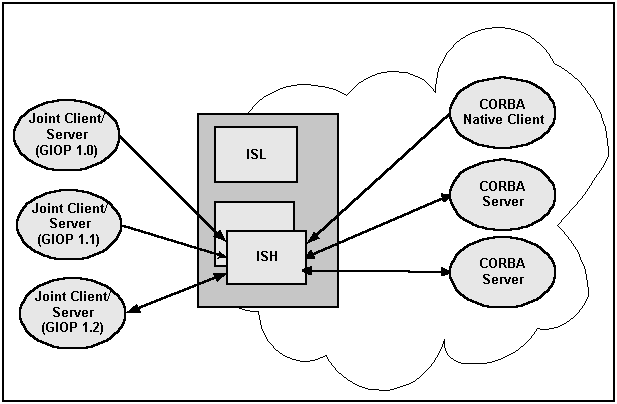


|

|
|
|
|
Configuring Outbound IIOP for Remote Joint Client/Servers
Support for outbound IIOP provides native clients and servers acting as native clients the ability to invoke on a remote object reference outside of the BEA Tuxedo domain. This means that calls can be invoked on remote clients that have registered for callbacks, and objects in remote servers can be accessed.
Administrators are the only users who interact directly with the outbound IIOP support components. Administrators are responsible for booting the ISLs with the correct startup parameters to enable outbound IIOP to objects not located in a connected client. Administrators may need to adjust the number of ISLs they boot and the various startup parameters to obtain the best configuration for their installation's specific workload characteristics.
Administrators have the option of booting the ISLs with the default parameters. However, the default BEA Tuxedo ISL startup parameters do not enable use of outbound IIOP.
Note: Outbound IIOP is not supported for transactions or security.
Functional Description
Outbound IIOP support is required to support client callbacks. In BEA WebLogic Enterprise versions 4.0 and 4.1, the ISL/ISH was an inbound half-gateway. Outbound IIOP support adds the outbound half-gateway to the ISL/ISH. (See Figure 12-2.)
There are three types of outbound IIOP connections available, depending on the version of GIOP supported by the native server and the remote joint client/server application:
Note: GIOP 1.2 is supported only by BEA WebLogic Enterprise release 4.2 (and later) and BEA Tuxedo release 8.0 (and later) C++ clients, servers, and joint client/servers. BEA WebLogic Enterprise releases 4.0 and 4.1 C++ clients and servers support GIOP versions 1.0 and 1.1, but not GIOP 1.2. Java clients, servers, and joint client/servers only support GIOP 1.0.
Bi-directional and dual-paired connection outbound IIOP provides outbound IIOP to object references located in joint client/servers connected to an ISH. Asymmetric outbound IIOP provides outbound IIOP to object references not located in a joint client/server connected to an ISH, and also allows BEA Tuxedo CORBA clients to invoke on any object reference, not only object references located in clients currently connected to an ISH.
Each type of outbound IIOP is described in more detail in the following sections.
Joint Client/Server IIOP Connections Supported
Bidirectional Outbound IIOP With bidirectional outbound IIOP, the following operations are executed (see Figure 12-3):
Bidirectional Connection
Asymmetric Outbound IIOP
With asymmetric outbound IIOP, the following operations are executed (see Figure 12-4):
Asymmetric Outbound IIOP
Dual-paired Connection Outbound IIOP
With dual-paired connection outbound IIOP, the following operations are executed (see Figure 12-5):
Dual-paired Connections Outbound IIOP
How the Routing Code Finds an ISL
The steps to finding an ISL are as follows:
Note: Normal BEA Tuxedo routing is used to find an ISL.
Note: Some invokes may be made to ISLs on nonlocal machines.

|

|
|
|
|
Copyright © 2001 BEA Systems, Inc. All rights reserved.
|